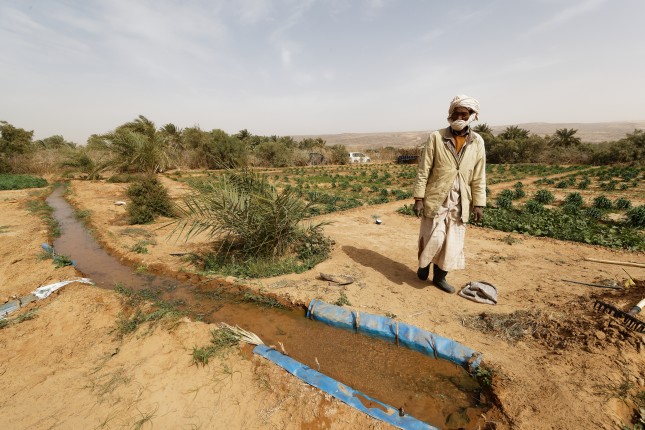-
Water: A matter of national security – and the best hope for our climate
Whiskey is for drinking, water is for fighting. Mark Twain may or may not have said it, but it gets repeated because it rings true. Water is central to human wellbeing, from drinking water and hygiene to growing food, producing electricity, and supporting identity-defining landscapes.
A new report from the Intergovernmental Panel on Climate Change (IPCC) confirms that the myriad impacts of a changing climate are already here, highlighting the need for immediate action to mitigate future impacts and adapt to impacts we cannot avoid. And while energy and emissions get the most press, water is central to how we experience these effects.
As changes to the earth’s climate impact both the supply of water and human demand for it, water security is threatened. Often framed and analyzed as personal (sufficient water being necessary for wellbeing and livelihoods), the issue trickles up, connecting the changing climate with national security at home and abroad.
As climate issues grow, so does the potential for water security problems
The IPCC report highlights the growing demand for water supplies that are becoming increasingly unreliable. This heightens the potential for competition and conflict—but also cooperation—over water.
Water is already a key pressure point in contemporary conflicts. Responding to Russia’s annexation of Crimea in 2014, Ukraine weaponized water, damming a key water supply and cutting off 85 percent of water flow. As Russian troops invaded Ukraine last month, they moved quickly to blow up the dam, reopening the water supply.
Changes in climate exacerbate droughts that lead to famine and floods causing large-scale displacement, increasing demand for humanitarian relief. When military support is needed for humanitarian assistance and disaster relief, this diverts resources from defense activities.
Water can also exacerbate conditions such as weak governance and ethnic tensions that set the stage for unrest and conflict. If farming becomes unprofitable due to drought-driven crop decline, for example, farmers may choose to fight for insurgents to be able to support their families.
Where governance and institutions are strong, however, water cooperation has been more common than conflict. Despite historically high tension between Israel and many of its Arab neighbors, the nation of Jordan signed a peace agreement with Israel in 1994 to more sustainably manage the rivers of the Jordan system. But as climate impacts disrupt water supply, whether this remains true moving forward will depend on human actions.
The good news: Change is possible
We do not downplay the serious nature of the IPCC’s report, but there is much we can do to soften the blow. Mitigating greenhouse gas emissions is critical, and another forthcoming IPCC report will focus on ways to do so. In the meantime, society must strive to adapt, particularly to water-related impacts.
As water resources change, human use of water must change as well. When demands are lower, reduced or fluctuating supplies need not lead to water insecurity. Beyond using water more efficiently in the activities we currently undertake, low-water alternatives exist for many day-to-day activities, from cleaning our hands with waterless disinfectants to eating high-nutrition, low-water foods.
For much of human history, water has been abundant and free, leading to products and processes that use water lavishly. Adapting to climate change may mean changing our expectations of how and where we “should” use water.
As humanity adapts to the many pressures of climate change and mitigates future change as much as possible, it is critical to ensure that adaptation and mitigation do not inadvertently exacerbate water insecurity. For example, irrigation can offset the effects of drought, but irrigating beyond replenishable supplies will run resources dry.
Not an easy task, but not impossible
Many of us learned about the water cycle in elementary science class. Water, evaporated by the sun to clouds, falling back to the earth as rain, running across land, through rivers, and into the ocean, only to evaporate and begin the cycle again. Climate change alters the rhythms of this cycle, but the fundamentals remain. The cycling of water means that though coming years may look different from what we’ve come to expect, we can adjust, adapt, and try again. This is cause for hope.
Critical to adapting to a changing water world is anticipating what those changes will be. From long-term climate projections to seasonal rainfall outlooks to tomorrow’s weather report, knowing what to expect will increase water security by helping us improve planning and response.
The IPCC report has consolidated a wide swath of data and scientific insight about our long-term water future, and seasonal and daily forecasts are generated constantly. Getting this data and insight into the hands of decision makers is the next crucial step in easing our transition into a warming world.
The U.S. Department of Defense, in its Defense Climate Risk Analysis, has identified numerous ways climate will impact national security. Operationalizing water data for national security decisions is one critical element of adapting to climate change and ensuring water security for all.
Col. Michael S. Gremillion (USAF, ret.) is director of the Global Water Security Center (GWSC) at The University of Alabama and former command meteorologist for the Air Force and Department of Defense.
Kate A. Brauman, Ph.D., is Associate Director for Communications and Analysis at the GWSC and a lead author on the 2021 United Nations Environmental Programme (UNEP) Global Synthesis Report, “Making Peace with Nature.”
Sources: Defense Security Cooperation Agency, IPCC, Reuters, United Nations, United Nations Department of Economic and Social Affairs, United States Department of Defense.
Photo Source: Farmer at Maaden El-Ervane, Mauritania, an oasis of the Adrar region famous for its numerous agriculture development programs, courtesy of Senderistas, Shutterstock.com.
 A Publication of the Stimson Center.
A Publication of the Stimson Center.




